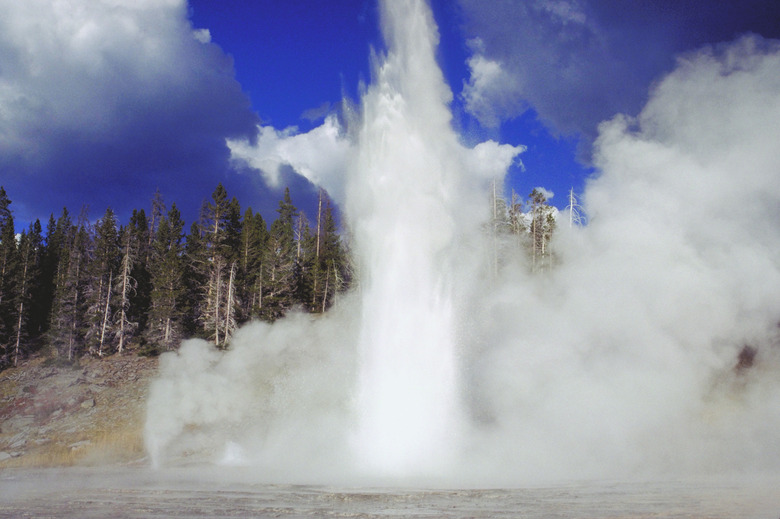Percentage Of Water Vapor In The Atmosphere
Earth's atmosphere contains about 78 percent nitrogen, 21 percent oxygen and 0.9 percent argon. The remaining 0.1 percent consists of carbon dioxide, nitrous oxides, methane, ozone and water vapor. Despite their small quantities, even tiny changes in these atmospheric gases impact the global energy balance and temperature. Water vapor, the most important greenhouse gas, fluctuates with temperature.
Percentage of Water Vapor in Air
Percentage of Water Vapor in Air
The percentage of water vapor in air varies based on temperature. The percent of water vapor in the cold Arctic and Antarctic (and highest Alpine regions) may reach as low as 0.2 percent while the warmest tropical air may contain up to 4 percent water vapor.
Water Vapor and Temperature
Water Vapor and Temperature
In short, the higher the dry air temperature, the more water vapor the air can hold. As air temperature cools, the water vapor content falls. So, the percentage of water vapor in air changes with temperature (and pressure). When the amount of water in the atmosphere reaches saturation, the humidity is 100 percent.
At a 100 percent saturation level, water vapor condenses to form water drops. If the water drops become large enough, rain falls. Smaller water droplets appear as clouds or fog. Below saturation, the percentage of water vapor in the atmosphere is usually reported as relative humidity.
Finding Relative Humidity
Finding Relative Humidity
Humidity refers to the amount of water in the atmosphere. Relative humidity compares the amount of water vapor in the atmosphere to the theoretical maximum amount of water vapor the air can hold at that temperature.
Relative humidity can be determined using special psychrometric charts and a sling psychrometer or two thermometers. A sling psychrometer consists of two thermometers mounted together on a small board attached to a swivel or short chain. One thermometer has a dry bulb. The second thermometer, the wet bulb thermometer, has the bulb wrapped with a piece of wet cloth.
The dry bulb thermometer measures air temperature. The wet bulb thermometer measures the temperature with the cooling effect of the evaporating water. To use, wet the cloth of the wet bulb thermometer and then swing the thermometers for 10 to 15 seconds. Read both temperatures.
Relative Humidity Temperature Difference
Relative Humidity Temperature Difference
Repeat the measurements above two or three times to be sure the wet bulb thermometer has reached its lowest reading. The difference between the two readings is used to find relative humidity. The greater the difference in readings, the lower the relative humidity.
At 86°F (30°C ), for example, a difference of 2.7°F (1.5°C ) means the relative humidity is very high at 89 percent, while a difference of 27°F (15°C) means the relative humidity is extremely low at 17 percent. On the psychrometric chart, the dry bulb thermometer readings are shown as vertical lines from the x-axis.
The wet bulb readings are shown as a curved line along the upper left portion of the chart. Find the intersection of the vertical dry bulb temperature line and the angled wet bulb temperature line to find the relative humidity.
Water Vapor and Absolute Humidity
Water Vapor and Absolute Humidity
Absolute humidity consists of the vapor concentration or density of the air. Absolute humidity can be calculated using the density formula:
**dv = mv ÷ V**
Where dv is the density of the vapor, mv is the mass of the vapor and V is the volume of air. The density or absolute humidity changes with changes in temperature or pressure because the volume (V) changes. The volume of air increases as temperature increases but decreases as pressure increases.
From the human perspective, the more humid the air, the more water vapor in the atmosphere. Evaporation decreases as the amount of water vapor in the air increases. Since sweat doesn't evaporate as easily when the water vapor capacity of the surrounding air is high, skin cooling is less effective when the humidity is high.
Why Water Vapor Matters
Why Water Vapor Matters
Water vapor, not carbon dioxide, is the Earth's most critical greenhouse gas. Besides the Sun, water vapor ranks as the second source of Earth's warmth, accounting for about 60 percent of the warming effect. Water vapor captures and holds warmth from the ground and carries that warmth into the atmosphere.
Water vapor moves heat from the equator toward the poles, distributing heat across the globe. Heat absorbed by water molecules provides the energy for evaporation. That water vapor rises into the atmosphere, carrying the heat up into the atmosphere.
As the water vapor rises, it eventually reaches levels where the atmosphere is less dense and the air colder. As the heat energy of the water vapor is lost to the surrounding colder air, the water vapor condenses. When enough water vapor condenses, clouds form. Clouds reflect sunlight, helping cool the Earth's surface.
References
- Space.com: Earth's Atmosphere: Composition, Climate & Weather
- North Carolina State University Climate Office: Composition of the Atmosphere
- American Chemical Society: It's Water Vapor, Not the CO2
- NASA Earth Observatory: Water Vapor
- Encyclopaedia Britannica: Humidity
- Encyclopaedia Britannica: Absolute Humidity
- Penn State: Humidity
- US Geological Survey: Condensation and the Water Cycle
- University of Nebraska – Lincoln Extension: Air Properties – Temperature and Relative Humidity
Cite This Article
MLA
Blaettler, Karen G. "Percentage Of Water Vapor In The Atmosphere" sciencing.com, https://www.sciencing.com/percentage-water-vapor-atmosphere-19385/. 2 July 2019.
APA
Blaettler, Karen G. (2019, July 2). Percentage Of Water Vapor In The Atmosphere. sciencing.com. Retrieved from https://www.sciencing.com/percentage-water-vapor-atmosphere-19385/
Chicago
Blaettler, Karen G. Percentage Of Water Vapor In The Atmosphere last modified March 24, 2022. https://www.sciencing.com/percentage-water-vapor-atmosphere-19385/
